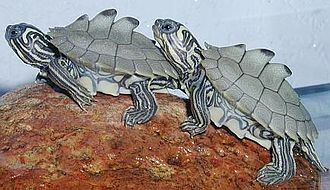Type the name of the breed you're looking for below
[wpdreams_ajaxsearchlite] Don't see the breed your're looking for? Click here and let us know!
Black-Knobbed Map Turtle
| Place of Origin and Range | The Black-Knobbed map turtle is endemic to the south eastern United States. In Alabama, they are found in the Mobile Bay drainage. In Mississippi, they are found in the Tombigbee River system and in the Black Warrior River as far north as Jefferson County, Alabama |
| Description | The carapace is dark olive-brown in colour. Within each pleural, or "plate", of the shell are yellow-green circular rings which are outlined in black. Hatchlings are similar in colour to adults, but the colours tend to be more vibrant and contrasting. The knob-like processes are compressed laterally. The head is small, and is dark brown with yellow stripes, with yellow crescents behind the eye facing towards the posterior end of the turtle. These stripes continue on the legs of the turtle also, with the underside of the leg being lighter than the dorsal surface. |
| Morph Patterns Available | Yes |
| Adult Size | Can grow up to 10 inches (25cm) |
| Accommodation | It is found in a wide variety of habitats, including slow-moving rivers, floodplain swamps, marshes, seasonal wetlands, and permanent ponds. A filtered aquarium with water temperature at 70-80'F(21-26'C), and a sloping ramp(driftwood, textured plastic or some other non-abrasive surface) leading from the bottom to an illuminated and warmed basking spot. Approx 80'F(27'C). 2 x 4 feet for an adult. |
| Lifespan | Can live 20+ years |
| Feeding / Diet | Snails, crayfish, minnows, worms, insects, and prepared foods such as pelleted trout, catfish pellets, and koi goldfish pellets. |
| Other Considerations | Watch for theses health concerns carefully with your turtle. Vitamin A Deficiency: Vitamin A is an important nutrient for your turtle’s health. It is found in his diet in the form of leafy green, orange or yellow vegetables, liver, and fish. If your turtle is not getting enough Vitamin A, he can suffer serious health problems. Always check to make sure that your turtle does not have swollen eyelids, as this is the main sign of a Vitamin A deficiency. Also, check for weight loss, nasal discharge and infected skin. Any of these symptoms could point to a deficiency. If you think your turtle may not be getting enough Vitamin A, you should take him to the veterinarian to get a firm diagnosis. Shell Problems: Your turtle’s shell is very important to his overall health. There are many potential problems that could occur, so you should be on the lookout at all times. Respiratory Disease: Respiratory infections have symptoms similar to vitamin A deficiency, including swollen eyelids and runny nose, so you should take your turtle to the veterinarian to get a proper diagnosis if you suspect either. More serious infections will be characterized by breathing through the mouth, mucus in the mouth, and wheezing. Always make sure your turtle’s environment has the proper amount of humidity, as this will help prevent respiratory problems. |



